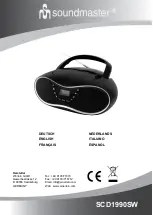
14
PM5000 Overview
Expansion:Connecting to External Equipment
The PM5000 is entirely self-contained and can be used
effectively on its own, but it does provide some versatile
expansion capabilities. In this section we’ll describe how
the PM5000 can be synchronized with external gear and
cascaded with other Yamaha mixing consoles.
Cascade
Two types of cascade connectors are provided on the
PM5000 rear panel: TYPE [A] for connection to a
second PM5000, and TYPE [B] for connection to
Yamaha PM4000/3500 series mixing consoles. In either
case the extra console will be added to increase the total
number of available input channels.
Type A
When the TYPE [A] connectors of two PM5000 consoles are
connected via a cross cable the functions listed below become
linked between the master and slave consoles. The slave console’s
utility mode can be used to specify reception of individual
parameters.
• VCA master section (mute & fade, fade time link).
• Mute master.
• The cue/solo setting (sync of all cue groups).
• Scene memory (synchronized storage and recall of the same
scene number).
The TYPE [A] port can also be connected to the serial RS-422 or
RS-232C port of a personal computer for offline console parameter
editing. PM5000 setup data can be transferred to and from the
console in standard CSV file format and edited in any spreadsheet
application that can import and export CSV data. The edited data
can then be directly read back into the PM5000.
Type B
The TYPE [B] cascade connector can be used to connect the
PM5000 to a Yamaha PM4000 or PM3500 series console for
linkage of the functions listed below. In this case the PM5000 will
function as the master console, there is no need to use the utility
mode to set the receive parameters. Cue/solo settings can,
however, be transmitted from the PM4000/3500.
• VCA master section (mute & fade, fade time link).
• Mute master (except for the PM3500).
• The cue/solo setting (sync of input cue only).
MIDI
The PM5000 MIDI connectors allow connection to other
MIDI equipment to provide the following capabilities:
• Program change message reception from an external MIDI
device for scene memory selection.
• Transmission of appropriate program change messages to
external MIDI gear when a scene memory is recalled on the
PM5000.
• Control change reception from an external MIDI device for
control of PM5000 panel control values.
• Transmission of appropriate control change messages to
external MIDI gear when a panel control is operated on the
PM5000.
In order to select the PM5000’s 1000 internal scene
memories using MIDI program change messages 1~128
it is necessary to use program change bank select
messages or create an program change table for the
PM5000. The program change table will also determine
which program change number is transmitted by the
PM5000 when a scene memory is recalled. MIDI
settings can be accessed via the console’s utility
functions. Also refer to the MIDI data list at the end of
this manual.
GPI (General Purpose Interface)
The GPI port allows pulse-signal interfacing with
compatible external equipment for bi-directional control
of several functions. Receive functions include
incrementing or decrementing of the PM5000 scene
memory and talkback on/off switching. GPI data can be
transmitted when a fader is operated (manually or
automatically), or when a specified scene memory is
recalled. All of these functions are accessible via the
PM5000 utility functions. Refer to the GPI Pin
Assignments chart at the end of this manual for more
information.
NOTE
See the detailed descriptions of the related utility functions in the
Utility Functions section beginning on page 56.
THRU
OUT
IN
MIDI
GPI
RS232C
RS422
MASTER
SLAVE
A
B
NOTE
Appropriate MIDI cables must be connected from the OUT
connector of the transmitting device to the IN connector of the
receiving device. The THRU connector on the receiving devices
re-transmits the data received at the IN connector. On the
PM5000 an “echo” function can be used to retransmit data
received at the IN connector via the OUT connector.
Summary of Contents for PM 5000 Series
Page 1: ...Owner s Manual E ...















































